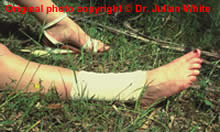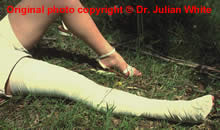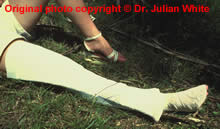


This important first aid method was developed by Dr. Struan Sutherland and colleagues at CSL and first published in 1978 in the prestigious international journal, "The Lancet". It is based on knowledge of the structure of important snake and spider toxins and previous clinical and experimental experience. It has been known for many years that the lymphatic system plays a key role in transport of toxins from the periphery to the circulation. In the case of snake venom toxins this is easily explained by the large size of these toxins. Clinically, adenopathy in nodes draining the bite site is often an early sign of absorption of venom, and in those tragic cases ending fatally, Sutherland was able to show high concentrations of venom in regional nodes.
The aim of this method is therefore to retard venom transport via the lymphatic system. This is achieved in a dual approach. Firstly the lymphatic vessels at the bite site are compressed by bandaging, extended to much of the rest of the bitten limb as possible. Secondly, proximal movement of lymph in the vessels is slowed or stopped by splinting the limb, thus also stopping the "muscle pump" effect of muscle movement. Correctly applied, this technique can virtually stop venom movement into the circulation until removed, up to hours later, without any threat to limb tissue oxygenation, which is just one of the major problems in using tourniquets. It must be remembered, however, that this method is only first aid. It is not definitive medical treatment for envenoming. Once in a hospital equipped to treat the bite with antivenom, if necessary, then all first aid should be removed after initial tests and precautions are taken. The details of these may be found in the following section on "Medical Treatment of Bites and Stings".
In summary, the pressure immobilisation method of first aid is:
• Apply a firm broad bandage or similar (even clothing strips or pantyhose will do in an emergency) over the bite site, at the same pressure as for a sprain. Do not occlude the circulation.
• Apply further bandage over as much of the rest of the bitten limb as practical. Ensure fingers or toes are covered to immobilise them. It is often easiest to go over the top of clothing such as jeans, rather than move the limb to remove clothing.
• Ensure the bitten limb is kept motionless by applying a splint and instructing the patient to cease all use of the limb and any general activity.



The pressure immobilisation method of first aid is ideal for Australian snakebite by all species, as well as bites from suspected funnel web spiders and mouse spiders, and for bites by the blue ringed octopus and cone. It is not appropriate for bites from the red back spider, other spiders, scorpions or centipedes or stings from venomous fish.